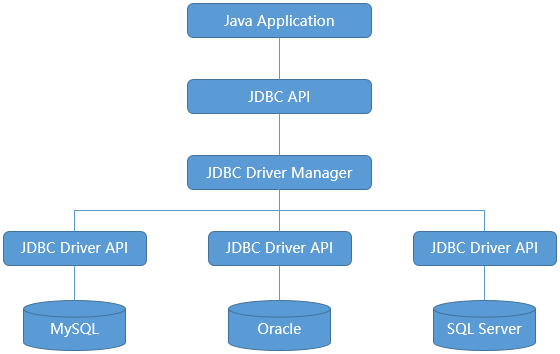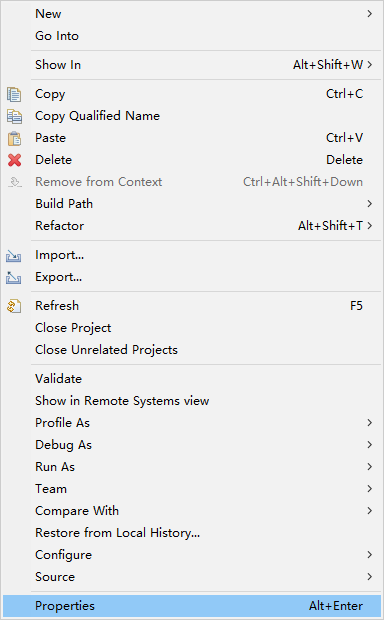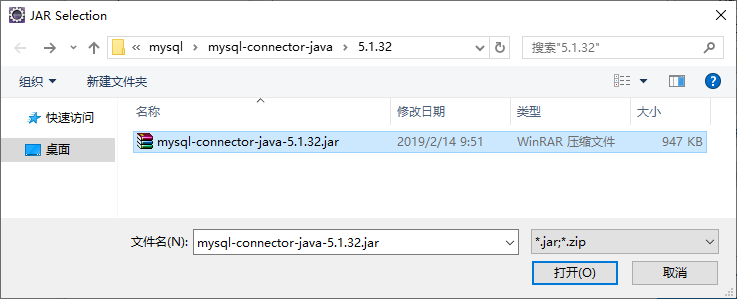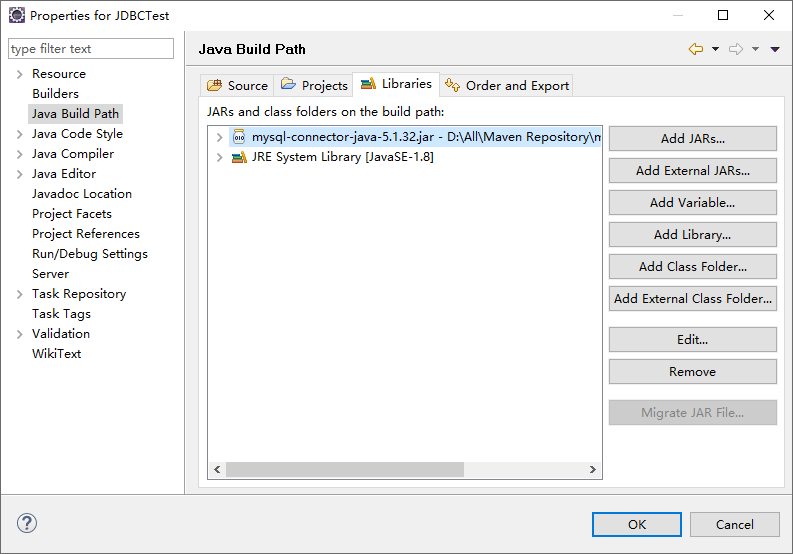Java操作数据库——使用JDBC连接数据库
摘要:本文主要学习了如何使用JDBC连接数据库。
背景
数据持久化
数据持久化就是把数据保存到可掉电式存储设备中以供之后使用。大多数情况下,特别是企业级应用,数据持久化意味着将内存中的数据保存到硬盘上加以“固化”,而持久化的实现过程大多通过各种关系数据库来完成。
持久化的主要应用是将内存中的数据存储在关系型数据库中,当然也可以存储在磁盘文件、XML数据文件中。
基础
概念
JDBC的全称是Java Database Connectivity,意为Java和数据库的连接。
JDBC是SUN公司提供的一套操作数据库的接口规范,定义了用来访问数据库的标准Java类库,使用这个类库可以更加方便地访问数据库资源。
程序员在使用数据库的时候,需要安装数据库驱动,不同的数据库的驱动也是不同的。所以为了程序员开发方便,SUN公司提供了一套接口,让数据库厂商实现这些接口,程序员只需要使用这个接口就可以操作不同的数据库,不需要关注底层数据库驱动的安装,从而大大简化和加快了开发过程。
架构
JDBC接口包括两个层次:
JDBC API:即面向应用的API,是一个抽象的接口,供应用程序开发人员使用,提供了程序到JDBC管理器的连接。
JDBC Driver API:即面向数据库驱动的API,需要开发商去实现这个接口,提供了JDBC管理器到数据库驱动程序的连接。

规范
主要有四个核心对象:
DriverManager类(java.sql.DriverManager):用于注册驱动,创建连接对象。
Connection接口(java.sql.Connection):表示与数据库创建的连接。
Statement接口(java.sql.Statement):执行数据库SQL语句,并返回相应结果的对象。
ResultSet接口(java.sql.ResultSet):结果集或一张虚拟表,用于存储表数据的对象。
其中,Statement接口还有两个子接口:
PreparedStatement接口(java.sql.PreparedStatement):预编译对象,是Statement接口的子接口,用于解决sql的注入问题。
CallableStatement接口(java.sql.CallableStatement):支持带参数的SQL操作,支持调用存储过程,是PreparedStatement接口的子接口。
连接数据库
下面的说明以连接MySQL数据库为例。
准备工作
拥有一个可以正常访问的MySQL数据库,已经可以登录使用的用户名和密码。
建立一个准备连接数据库的项目。
导入jar包
导入Java连接MySQL所用到的jar包,这个jar包通常是由数据库的厂商提供的,这里下载的是 mysql-connector-java-5.1.32.jar 这个包。
那Eclipse为例,在项目上右键,然后点击Properties:

然后在弹出的页面左侧找到 Java Build Path 目录并进入,选择 Libraries 标签页,找到标签页右侧的 Add External JARs... 按钮:

找到下载的jar包,点击打开:

可以看到jar包被成功导入到项目中:

点击OK完成导入。
加载驱动
加载数据库驱动的方法是调用Class类的静态方法forName。语法格式如下:
1 public static Class<?> forName(String className)
其中,传入的参数className是每个数据库厂商各自提供的一个驱动程序名称。
不同的数据库,驱动程序名称如下:
1 MySQL驱动:com.mysql.jdbc.Drive 2 Oracle驱动:oracle.jdbc.driver.OracleDriver 3 SQLServer驱动:com.microsoft.sqlserver.jdbc.SQLServerDriver 4 PostgreSQL驱动:org.postgresql.Driver 5 DB2驱动:com.ibm.db2.jdbc.net.DB2Driver 6 Sybase驱动:com.sybase.jdbc.SybDriver
建立连接
使用DriverManager类的静态方法getConnection建立到指定数据库的连接。语法格式如下:
1 public static Connection getConnection(String url, String user, String password)
url是SUN公司与数据库厂商之间的一种协议,user是连接数据库的用户名,password是用户名对应的密码。
不同的数据库,url协议的格式如下:
1 MySQL格式:jdbc:mysql://地址或主机名:端口号/数据库名 2 Oracle格式:jdbc:oracle:thin:@地址或主机名:端口号:数据库名 3 SQLServer格式:jdbc:sqlserver://地址或主机名:端口号;databaseName=数据库名 4 PostgreSQL格式:jdbc:postgresql://地址或主机名:端口号/数据库名 5 DB2格式:jdbc:db2:地址或主机名:端口号/数据库名 6 Sybase格式:jdbc:sybase:Tds:地址或主机名:端口号/数据库名
如果是在本机并且用的是默认的端口号,可以将地址和端口号省略:
1 jdbc:mysql:///数据库名
建议url中的文件编码、数据库连接编码、数据库编码保持一致,向数据库中添加数据时,连接参数最好包含Unicode字符支持,这样添加的字符就能被数据库识别并且正常显示了:
1 jdbc:mysql://地址或主机名:端口号/数据库名?useUnicode=true&characterEncoding=UTF-8
至此,就成功获取到了连接MySQL数据库的Connection对象。
执行语句
获取到连接之后,使用Connection接口的createStatement方法获取Statement对象。语法格式如下:
1 Statement createStatement()
获取到了Statement对象之后,使用executeQuery方法执行查询语句得到ResultSet类型的结果集,使用executeUpdate方法执行增加、删除、修改语句得到int类型的记录数。
释放连接
数据库连接Connection是非常稀有的资源,用完后必须马上释放,如果Connection不能及时正确的关闭将导致系统宕机。Connection的使用原则是尽量晚创建,尽量早的释放。
释放的方法是通过调用Connection的close方法,语法格式如下:
1 void close()
一次完整的操作数据库的流程包括加载驱动、建立连接、执行语句、释放连接。其中,加载驱动只执行一次即可,建立的连接用完之后必须马上释放。
连接数据库实例
在程序里配置连接信息
完整代码如下:
1 public static void main(String[] args) { 2 try { 3 Class.forName("com.mysql.jdbc.Driver"); 4 } catch (ClassNotFoundException e) { 5 e.printStackTrace(); 6 } 7 Connection conn = null; 8 try { 9 String url = "jdbc:mysql://192.168.35.128:3306/demo"; 10 String user = "root"; 11 String password = "123456"; 12 conn = DriverManager.getConnection(url, user, password); 13 } catch (Exception e) { 14 e.printStackTrace(); 15 } finally { 16 try { 17 conn.close(); 18 } catch (SQLException e) { 19 e.printStackTrace(); 20 } 21 } 22 }
在配置文件里配置连接信息
配置文件 jdbc.properties 在 src 目录下,和当前的源文件的根目录 package jdbc; 平级,内容如下:
1 driverClass=com.mysql.jdbc.Driver 2 url="jdbc:mysql://192.168.35.128:3306/demo" 3 user=root 4 password=123456
完整代码如下:
1 public static void main(String[] args) { 2 Properties pros = new Properties(); 3 try { 4 pros.load(TestConnection.class.getClassLoader().getResourceAsStream("jdbc.properties")); 5 } catch (IOException e) { 6 e.printStackTrace(); 7 } 8 try { 9 Class.forName(pros.getProperty("driverClass")); 10 } catch (ClassNotFoundException e) { 11 e.printStackTrace(); 12 } 13 Connection conn = null; 14 try { 15 String url = pros.getProperty("url"); 16 String user = pros.getProperty("user"); 17 String password = pros.getProperty("password"); 18 conn = DriverManager.getConnection(url, user, password); 19 } catch (Exception e) { 20 e.printStackTrace(); 21 } finally { 22 try { 23 conn.close(); 24 } catch (SQLException e) { 25 e.printStackTrace(); 26 } 27 } 28 }
增删改查
查询
使用实例:
1 public static void main(String[] args) { 2 try { 3 Class.forName("com.mysql.jdbc.Driver"); 4 } catch (ClassNotFoundException e) { 5 e.printStackTrace(); 6 } 7 Connection conn = null; 8 Statement stmt = null; 9 ResultSet rs = null; 10 try { 11 String url = "jdbc:mysql://192.168.35.128:3306/demo"; 12 String user = "root"; 13 String password = "123456"; 14 conn = DriverManager.getConnection(url, user, password); 15 stmt = conn.createStatement(); 16 rs = stmt.executeQuery("select * from student"); 17 while (rs.next()) { 18 System.out.println(rs.getInt("id") + " " + rs.getString(2) + " " + rs.getString(3) + " " + rs.getString("address")); 19 } 20 } catch (Exception e) { 21 e.printStackTrace(); 22 } finally { 23 try { 24 rs.close(); 25 } catch (SQLException e) { 26 e.printStackTrace(); 27 } 28 try { 29 stmt.close(); 30 } catch (SQLException e) { 31 e.printStackTrace(); 32 } 33 try { 34 conn.close(); 35 } catch (SQLException e) { 36 e.printStackTrace(); 37 } 38 } 39 }
增加、修改、删除
使用实例:
1 public static void main(String[] args) { 2 try { 3 Class.forName("com.mysql.jdbc.Driver"); 4 } catch (ClassNotFoundException e) { 5 e.printStackTrace(); 6 } 7 Connection conn = null; 8 Statement stmt = null; 9 try { 10 String url = "jdbc:mysql://192.168.35.128:3306/demo"; 11 String user = "root"; 12 String password = "123456"; 13 conn = DriverManager.getConnection(url, user, password); 14 stmt = conn.createStatement(); 15 int count = stmt.executeUpdate("delete from student where id = 903"); 16 System.out.println("受影响的行数:" + count); 17 } catch (Exception e) { 18 e.printStackTrace(); 19 } finally { 20 try { 21 stmt.close(); 22 } catch (SQLException e) { 23 e.printStackTrace(); 24 } 25 try { 26 conn.close(); 27 } catch (SQLException e) { 28 e.printStackTrace(); 29 } 30 } 31 }
Statement接口
Statement接口是通过Connection的createStatement方法获取的,用来执行SQL语句并返回相应的结果。语法格式如下:
1 Statement createStatement()
使用完之后需要手动关闭Statement对象。
PreparedStatement接口
PreparedStatement接口是通过Connection的preparedStatement方法获取的,是Statement的子接口,表示一条预编译过的SQL语句。语法格式如下:
1 PreparedStatement prepareStatement(String sql)
传入的SQL语句中的参数用问号“?”来表示,调用PreparedStatement对象的setXxx方法来设置这些参数。setXxx方法有两个参数,第一个参数是要设置的参数索引(从1开始),第二个是设置的参数值。
使用Statement可能会因为字符串拼接导致被人SQL注入攻击,但使用PreparedStatement不需要拼接字符串,而是使用占位符的方法,有效避免了SQL注入攻击的问题。
使用举例:
1 pstmt = conn.prepareStatement("select * from student where id = ?"); 2 pstmt.setInt(1, 904); 3 rs = pstmt.executeQuery(); 4 while (rs.next()) { 5 System.out.println(rs.getString(1) + " " + rs.getString(2) + " " + rs.getString(3) + " " + rs.getString("address")); 6 }
ResultSet接口
使用Statement接口的executeQuery方法执行传入的查询语句,并得到ResultSet类型的结果集。语法格式如下:
1 ResultSet executeQuery(String sql)
ResultSet接口由数据库厂商实现,以逻辑表格的形式封装了执行数据库操作的结果集。
ResultSet对象维护了一个指向当前数据行的游标,游标默认从1开始,可以通过next方法移动到下一行。
使用完之后需要手动关闭ResultSet对象。
常用方法:
1 byte getByte(int columnIndex) throws SQLException; 2 byte getByte(String columnLabel) throws SQLException; 3 byte[] getBytes(int columnIndex) throws SQLException; 4 byte[] getBytes(String columnLabel) throws SQLException; 5 short getShort(int columnIndex) throws SQLException; 6 short getShort(String columnLabel) throws SQLException; 7 int getInt(int columnIndex) throws SQLException; 8 int getInt(String columnLabel) throws SQLException; 9 long getLong(int columnIndex) throws SQLException; 10 long getLong(String columnLabel) throws SQLException; 11 float getFloat(int columnIndex) throws SQLException; 12 float getFloat(String columnLabel) throws SQLException; 13 double getDouble(int columnIndex) throws SQLException; 14 double getDouble(String columnLabel) throws SQLException; 15 String getString(int columnIndex) throws SQLException; 16 String getString(String columnLabel) throws SQLException; 17 boolean getBoolean(int columnIndex) throws SQLException; 18 boolean getBoolean(String columnLabel) throws SQLException; 19 java.sql.Date getDate(int columnIndex) throws SQLException; 20 java.sql.Date getDate(String columnLabel) throws SQLException; 21 java.sql.Time getTime(int columnIndex) throws SQLException; 22 java.sql.Time getTime(String columnLabel) throws SQLException; 23 java.sql.Timestamp getTimestamp(int columnIndex) throws SQLException; 24 java.sql.Timestamp getTimestamp(String columnLabel) throws SQLException; 25 Object getObject(int columnIndex) throws SQLException; 26 Object getObject(String columnLabel) throws SQLException; 27 28 boolean next() throws SQLException; 29 void close() throws SQLException; 30 31 ResultSetMetaData getMetaData() throws SQLException;
使用举例:
1 stmt = conn.createStatement(); 2 rs = stmt.executeQuery("select * from student"); 3 while (rs.next()) { 4 System.out.println(rs.getInt("id") + " " + rs.getString(2) + " " + rs.getString(3) + " " + rs.getString("address")); 5 }
ResultSetMetaData接口
ResultSetMetaData对象可以用来获取ResultSet对象中列的类型和属性信息。
常用方法:
1 int getColumnCount() throws SQLException; 2 int getColumnTypeName(int column) throws SQLException; 3 String getColumnLabel(int column) throws SQLException; 4 String getColumnName(int column) throws SQLException;
使用举例:
1 stmt = conn.createStatement(); 2 rs = stmt.executeQuery("select * from student"); 3 while (rs.next()) { 4 ResultSetMetaData rsmd = rs.getMetaData(); 5 System.out.println(rsmd.getColumnName(1) + "=" + rs.getInt("id") + " " + rsmd.getColumnName(2) + "=" + rs.getString(2)); 6 }